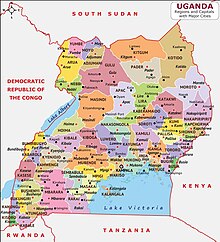





Ugandan folklore includes traditional folktales and other folklore from the African country of Uganda. The convey meaning and experiences from generation to generation.[1] Traditionally, folktales instilled discipline and good behaviour that shaped societal beliefs and norms within Ugandan society.[2]

Folktales from Northern Uganda include the story of Mighty Angwech,[3] the Hare's Marriage, and The Shoe-Maker and the Monkey.[4] They were studied by Kyambogo University and Makerere University.[5] The Acholi tribe refer to their folktales as ododo pa Achali meaning "Folktales of the Acholi" and some of them include many stories about rabbits and hares in the wild.[citation needed]

The Teso community of Eastern Uganda, offers the great folktale of Oduk the conqueror. He led the Teso people from South Sudan to Eastern Uganda and ultimately to western Kenya.[6]

In the Gisu tribe, male circumcision, known as Imbalu, is a famous annual ceremony that retells the Bugisu story of boys transiting into men.[7]
In Western Uganda, folktales can be found among the Bunyoro, Banyankole, Bachiga,[8] and other groups. In Bunyoro an epic story is told of the Batembuzi who founded Bunyoro Kingdom. Their stories tell of mythical gods and the heavens and the underworld. Heaven was led by Ruhanga and the underworld or earth ruled by an outcast thrown from heaven.[9]

InBuganda, Nambi and Kintu folktales tell a story that long ago, Kintu was the only man in Uganda. He had one cow.[10] Up in the sky existed a kingdom whose king was named Ggulu. He had handsome sons and beautiful daughters who loved watching the rainbow. One day, Ggulu's sons called their sister Nambi to join them to play at the foot of a rainbow. They did not know that the land the rainbow touched was Uganda. They became frightened, as Nambi and her brothers had never seen a man. Nambi with her kind heart promised to come back and marry Kintu so he would never be lonely again.[10] Other Buganda folktales include the story of Walukaga the blacksmith, Mpobe the hunter, and Kasanke the little red bird.[10][11] Folktales in Buganda are also about hares, leopards , rabbits and other animals that live in the wild and one of the famous folk stories is about wango and wakayima. Wango is a leopard while wakayima is a rabbit.
